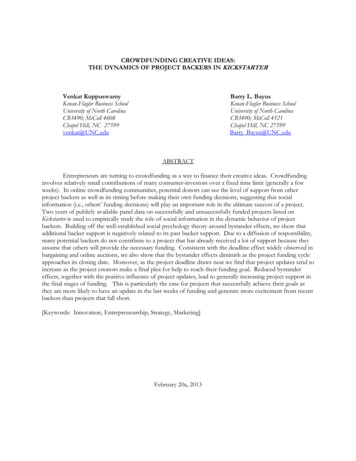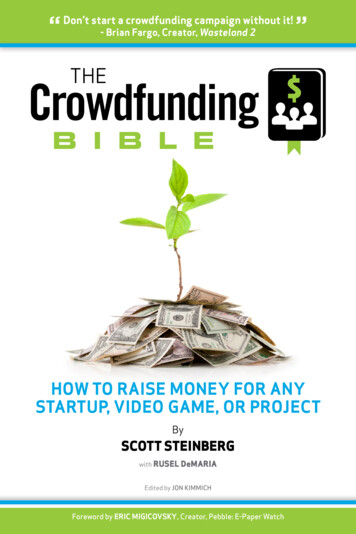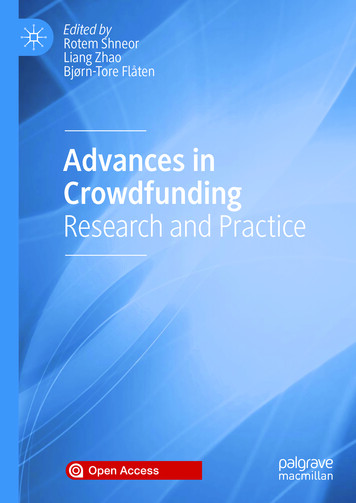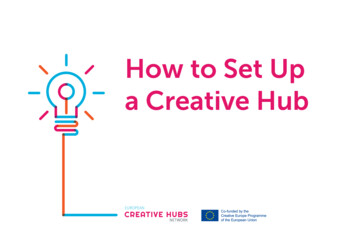
Transcription
CROWDFUNDING CREATIVE IDEAS:THE DYNAMICS OF PROJECT BACKERS IN KICKSTARTERVenkat KuppuswamyKenan-Flagler Business SchoolUniversity of North CarolinaCB3490; McColl 4608Chapel Hill, NC 27599venkat@UNC.eduBarry L. BayusKenan-Flagler Business SchoolUniversity of North CarolinaCB3490; McColl 4521Chapel Hill, NC 27599Barry Bayus@UNC.eduABSTRACTEntrepreneurs are turning to crowdfunding as a way to finance their creative ideas. Crowdfundinginvolves relatively small contributions of many consumer-investors over a fixed time limit (generally a fewweeks). In online crowdfunding communities, potential donors can see the level of support from otherproject backers as well as its timing before making their own funding decisions, suggesting that socialinformation (i.e., others’ funding decisions) will play an important role in the ultimate success of a project.Two years of publicly available panel data on successfully and unsuccessfully funded projects listed onKickstarter is used to empirically study the role of social information in the dynamic behavior of projectbackers. Building off the well-established social psychology theory around bystander effects, we show thatadditional backer support is negatively related to its past backer support. Due to a diffusion of responsibility,many potential backers do not contribute to a project that has already received a lot of support because theyassume that others will provide the necessary funding. Consistent with the deadline effect widely observed inbargaining and online auctions, we also show that the bystander effects diminish as the project funding cycleapproaches its closing date. Moreover, as the project deadline draws near we find that project updates tend toincrease as the project creators make a final plea for help to reach their funding goal. Reduced bystandereffects, together with the positive influence of project updates, lead to generally increasing project support inthe final stages of funding. This is particularly the case for projects that successfully achieve their goals asthey are more likely to have an update in the last weeks of funding and generate more excitement from recentbackers than projects that fall short.[Keywords: Innovation, Entrepreneurship, Strategy, Marketing]February 20a, 2013
1. INTRODUCTIONAn important barrier to innovation is the availability of early-stage funding (Cosh, et al. 2009). Giventhe difficulties that new ventures face in attracting financing from angel investors, banks and venture capitalfunds, some entrepreneurs are tapping into large, online communities of consumer-investors (Economist2010; Schwienbacher and Larralde 2012). Called “crowdfunding,” this relatively new form of informalventure financing allows entrepreneurs to directly appeal to the general public (i.e., the “crowd”) for help ingetting their innovative ideas off the ground. As defined by Belleflamme, et al. (2012), crowdfunding involvesan open call (through the Internet) for the provision of financial resources either in the form of donation orin exchange for some form of reward in order to support initiatives for specific purposes1.Collecting small amounts of money from a large number of people has a rich history in manydomains (Ordanini, et al. 2011). For example, Mozart and Beethoven financed concerts and new musiccompositions with money from interested patrons, the Statue of Liberty in New York was funded by smalldonations from the American and French people, a human rights organization is trying to raise money inorder to buy a communications satellite to provide Internet access to people in third world countries(http://www.buythissatellite.com, accessed November 2, 2012), and President Barak Obama’s 2008 electioncampaign raised most of its funds from small donations over the Web (Hemer 2011). Today, several hundredglobal intermediaries with online platforms exist to match up consumer investors with initiatives that theywish to help fund. Prominent examples in the popular press include the narrative movie project by SteveTaylor that got almost 4,500 people to contribute nearly 350,000 and Scott Wilson’s idea to create awristband that will convert an iPod nano into a watch raised over 940,000 from over 13,500 individuals(Adler 2011). One of the largest crowdfunded projects to date is Eric Migicovsky’s E-Paper Watch thatintegrates with an Android or iPhone that received donations totaling over 10.2M from well over 65,000backers (Segall 2012). According to one industry report, crowdfunding platforms raised almost 1.5B andsuccessfully funded more than one million projects in 2011 (Massolution 2012). Given the potential dollarsinvolved, crowdfunding has recently garnered attention from policymakers and regulators as evidenced by theJumpstart Our Business Startups Act (JOBS Act) recently signed into U.S. law (Chasan 2012).Crowdfunding differs from the traditional financing of new ventures in two important ways. First,funding is provided by the relatively small contributions of many individuals over a fixed time limit (generallya few weeks). Second, potential donors can see the level of support from other project backers as well as itstiming before making their own funding decisions, suggesting that social information (i.e., others’ fundingdecisions) will play an important role in the ultimate success of a crowdfunded project. Understanding theseeffects is important because studies find that social information can lead to “non-rational” behaviors. Forexample, people often choose music for downloading based on popularity not quality (Salganik, et al. 2006)1Thisis conceptually similar to crowdsourcing in which community members (non-experts) propose new product andservice ideas, as well as comment on and vote for the ideas of others (Bayus 2013).1
and bidders tend to herd into online auctions with more bids even though this activity is not a signal of higherquality (Simonsohn and Ariely 2008). Many legal scholars and policy makers believe that this kind ofirrational herding behavior increases the chances for fraud in crowdfunded projects since consumerinvestments are not protected by government regulations or oversight (Bradford 2012; Hazen 2012). To datehowever, there is very little empirical research to definitively support any position.In general, crowdfunding communities differ in terms of whether the funder’s primary motivationfor participating is the expectation of a financial return. For example, crowdfunding communities likeSellaBand and Wefunder offer consumer investors an interest in the venture in the form of equity or some sortof profit sharing agreement (Ward and Ramachandran 2010; Agarwal, et al. 2011). Other crowdfundingcommunities such as Prosper and Zopa involve peer-to-peer lending in which it is expected that the originalprincipal is repaid, along with some fixed interest (Herzenstein, et al. 2011; Zhang and Liu 2012). Researchon these types of equity- and lending-based crowdfunding communities finds evidence for herding behavior,i.e., individuals want to contribute to projects that already have a lot of support from other communitymembers. Because consumer investors in these communities expect a financial return, herding behavior is a“rational” way for individuals to reduce their own risk in the face of uncertainty about the proposed newventures on these websites. Following the literature on information cascades (Bikhchandani, et al. 1992),these studies argue that an initiative with a lot of community support signals that the project is of high quality.Unlike the platforms in which participants expect some sort of financial return, other crowdfundingcommunities involve no monetary compensation for participation. For example, JustGiving and Spot.us rely onaltruistic motivations in which funders voluntarily donate their money with no expectations of any tangiblereward (Burtch, et al. 2012; Smith, et al. 2012). Research on these types of donation-based crowdfundingcommunities draw on the extensive literature involving philanthropy and public goods (Andreoni 2006;Vesterlund 2006). Because the consumption of public goods cannot be withheld from non-contributors,free-riding is a potential issue in which contributions can be crowded-out by the prior funding decisions ofothers (Bergstrom, et al. 1986). At the same time, there are several models based on social norms that predicta positive effect of others’ funding decisions (Sugden 1984; Bernheim 1994). Depending on the perspectivetaken, some donation-based crowdfunding studies find positive effects for other community members’funding decisions on contributions (Smith, et al. 2012), while others find the opposite (Burtch, et al. 2012).Unlike existing research that considers crowdfunding communities with tangible financial returns orno tangible rewards at all, our interest is in crowdfunding communities like Kickstarter and Indiegogo in whichproject backers do receive tangible, but non-financial, benefits for their financial contributions. Theserewards often take the form of tokens of appreciation (thank-you message, artist’s autograph, mentioning thecrowdfunder’s name in the credits, tee-shirt) or the pre-purchasing of products or services (Hemer 2011).Not surprisingly, qualitative studies find that rewards are one of the most important motivations forparticipating in crowdfunding communities (de Witt 2012; Gerber, et al. 2012; Steinberg 2012). Reward2
based crowdfunding has the largest number of online platforms and is the fastest growing form ofcrowdfunding (Massolution 2012). With the exception of Mollick’s (2012) cross-sectional study, very littleresearch to date has considered reward-based crowdfunding and none has examined the role of socialinformation.[insert Figure 1 about here]The empirical setting for our study is one of the oldest and largest reward-based crowdfundingcommunities on the Web. Since its launch in April 2009, Kickstarter has over one million communitymembers who have combined to pledge hundreds of millions of dollars to fund creative ideas in categorieslike art, film and video, dance, design, and technology (Ricker 2011). Anecdotal cases studies suggest thatKickstarter projects tend to get a lot of backer support in the first and last weeks of their funding cycle—friends and family tend to be early project supporters, while strangers, who make up the majority ofcontributors, often provide funding as a project nears its conclusion (de Witt 2012; Steinberg 2012). As anexample, consider the backer support over time for Cody Webb’s New CD (a music project supported by 89backers that successfully achieved funding of 12,701) shown in Figure 1. This “bathtub” shaped pattern ofbacker support is sharply different than the generally increasing pattern associated with herding observed withequity or lending-based crowdfunding (e.g., Zhang and Liu 2012) or the decreasing pattern found withdonation-based crowdfunding (Burtch, et al. 2012). Although this pattern of backer support is well known byreward-based crowdfunding pundits (de Witt 2012; Mod 2010; Steinberg 2012), insights into its drivers arelacking.Two years of publicly available information on successfully and unsuccessfully funded Kickstarterprojects is used to empirically study the role of social information in the dynamic behavior of project backers.To explain the observed bathtub shaped pattern of backer support over time, we introduce a new theoreticallens. Building off the well-established social psychology theory around bystander effects (Fisher, et al. 2011),we show that backer support for a reward-based crowdfunding project is negatively related to its past backersupport. Due to a diffusion of responsibility, many potential backers do not contribute to a project that hasalready received a lot of support because they assume that others will provide the necessary funding. As aresult, initial project excitement is quickly followed by a strong downward trend in backer support.Consistent with the deadline effect widely observed in bargaining and online auctions (Roth, et al. 1988;Ariely and Simonson 2003), we also show that the bystander effects diminish as the project funding cycleapproaches its closing date. Moreover, as the project deadline draws near we find that project updates tend toincrease as the project creators make a final plea for help to reach their funding goal. Reduced bystandereffects, together with the positive influence of project updates, inertia from recent backers and exposure onthe Kickstarter web site, lead to generally increasing project support in the final stages of funding. This isparticularly the case for projects that successfully achieve their goals as they are more likely to have an update3
in the last weeks of funding and generate more excitement from recent backers than projects that ultimatelyfall short.2. THE THEORETICAL FRAMEWORKIn this section, the theoretical framework that guides our empirical study is discussed. Our interest isin reward-based crowdfunding communities like Kickstarter that offer tangible, but non-financial, benefits forthe financial contributions of project backers. Given this context, rational herding behavior due to uncertainproject quality is unlikely for Kickstarter projects because there is no expectation of a financial return. WhileBurtch, et al. (2012) and Smith, et al. (2012) argue that donation-based crowdfunding involves the provisionand consumption of a public good, this is not the case with reward-based crowdfunding. Importantly, thecreative ideas posted on Kickstarter do not have the properties of being non-excludable and non-rivalrous.Reciprocity (Sugden 1984) and conformity (Bernheim 1994) are also not expected to operate in thisenvironment since donors are anonymous and specific donation amounts are not visible. Moreover, ifindividuals care mostly about the end result (i.e., provision of the public good), then any crowding-out effectsof social information should not vary over time. And, to the extent that individuals in the public goodssituation care only about the size of their donation and how it makes them feel, there is no role for socialinformation, i.e., the contributions of donors are unrelated in that one person’s donation does not affect theutility someone else receives from giving (Duncan 2004).Instead, we build off the well-established social psychology theory involving the bystander effect(Fischer, et al. 2011). Studies on the bystander effect demonstrate that an individual’s likelihood of helpingdecreases in the actual or perceived presence of others (Darley and Latane 1968; Latane and Darley 1970;Garcia, et al. 2002). Importantly, the bystander effect is a robust phenomenon that occurs in manyexperimental and field situations. The original research program on the bystander effect was in response tothe very sad real-life case of Catherine Genovese who was raped and murdered in New York while several ofher neighbors looked on and did not report the attack to the police (Latane and Nida 1981). Literaturereviews by Latane and Nida (1981) and Fisher, et al. (2011) show that the bystander effect operates in manydiverse situations, including non-emergencies (e.g., answering the door, helping with a flat tire, leaving a tip).Moreover, the bystander effect occurs for nearly all age groups (except for very young children) as well as forboth genders (Latane and Nida 1981). The bystander effect has also been observed with donation behavior(Wiesenthal, et al. 1983).Latane and Darley (1970) propose a decision model that a bystander must go through beforeintervening in a critical situation. First, bystanders need to notice the situation. Bystanders must theninterpret the situation as one in which action is necessary, and then develop a feeling of personalresponsibility (empathy). Next, bystanders need to believe they have the skills and resources to help. Finally,they must decide to actually take action to help. Although presented as a linear sequence, this decision modelis meant to be iterative—at any point in this decision model, the bystander can cycle back to a previous4
decision step. Bystanders can exhibit signs of discomfort over inaction if they find it difficult to reach adecision in any stage of this decision model. In addition, delayed responses will often lead to inactionaltogether—the longer bystanders wait to respond, the less likely they are to ever help. Based on anecdotalreports, this general model seems to capture the key decisions made by backers in crowdfunding communitieslike Kickstarter (de Witt 2012; Gerber, et al. 2012; Steinberg 2012).Latane and Darley (1970) identify three different social psychological processes that can interferewith the completion of this decision sequence. The first process is diffusion of responsibility in which peoplefail to help because they assume someone else will do so. In this case, the knowledge that others couldinstead respond reduces their feelings of personal responsibility and thus, inhibits helping. Individuals tendto subjectively divide their own personal responsibility to help by the number of bystanders. This idea isclosely related to social loafing (“a reduction in motivation and effort when individuals work collectivelycompared with when they work individually,” Karau and Williams 1993: 681). The diffusion of responsibilitypredicts that the likelihood of helping is directly related to the size of the bystander group (Forsyth, et al.2000). The second process is pluralistic ignorance (or social influence) in which people tend to rely on theovert reactions of others when interpreting an ambiguous situation. In this case, individuals look for cues inthe environment that can help them determine whether action is necessary. As noted by Cialdini (2001: 100),we “view other behavior as correct in a given situation to the degree that we see others performing it.” Astrong bystander effect occurs when no one helps because everyone believes that no one else perceives anemergency. The third process is audience inhibition (or evaluation apprehension) in which people feel therisk of embarrassment if the situation is misinterpreted. In other words, individuals are reluctant to helpbecause they are afraid of making mistakes or acting in a way that might be negatively evaluated by onlookers.Given the inherent characteristics of online crowdfunding communities like Kickstarter (creators, backers andcommunity members are for the most part anonymous, and the projects are not ambiguous in that they allexplicitly ask for financial help), the audience inhibition and pluralistic ignorance processes are not as relevantas the diffusion of responsibility.Extending the literature which focuses on the bystander effect in face-to-face situations, more recentstudies find evidence for the virtual diffusion of responsibility in computer-mediated communication andonline communities. For example, Barron and Yechiam (2002) show that the presence of others copied in aprivate email communication reduces one’s willingness to reply to a request for help. Markey (2000) showsthat the time it takes to receive help in online chat groups increases with group size. Yechiam and Barron(2003) find that significantly more people that were emailed individually completed an online survey ascompared to a general request sent to members of a Listserv. Voelpel, et al. (2008) examine virtual bystandereffects in a number of large online communities consisting of Yahoo!Groups members. They show that thelikelihood of responding to a help request and the quality of response is significantly related to group size:5
small groups are more likely to respond and more likely to have a high quality response than larger groups. Inall these studies, perceived group size is negatively related to helping behavior.To date, the published literature has only considered cross-sectional variation in group size todemonstrate the bystander effect. In the crowdfunding context we study however, time-series variation ingroup size within a project is of prime interest. Help in the form of financial support can come at any pointduring a project’s funding cycle before it has reached its funding goal. Moreover, perceptions about thenumber of others that might provide funding will also vary over time. For each time period during thefunding cycle, we argue that potential Kickstarter backers use the list of publicly displayed backers alreadysupporting a project as an indicator of the size of the group that could provide the remaining funding. Thisapproach of using past project support to gauge future support is consistent with related research (Voelpel, etal. 2008) as well as recommendations on how to plan and manage a Kickstarter campaign (Mod 2010; de Witt2012; Steinberg 2012). Due to a diffusion of responsibility, many prospective backers do not contribute to aproject that has already received a lot of support because they assume that someone else will provide theremaining financing. Thus, the bystander effect predicts that project support at any time over its fundingcycle is negatively related to the level of support it received prior to that time. The following hypothesissummarizes these arguments.H1: The likelihood a reward-based crowdfunding project receives additional backer support is negatively related to itspast backer support.According to Kickstarter statistics, a lot of backer support comes in the later stages of a project’sfunding cycle. Matt Haughey, a backer of more than 150 Kickstarter projects, sums it up this way (Steinberg2012: 149): once you pass 50 percent of your funding, at any point, you have a 95 percent chance ofreaching your goal. There’s a human psychology element where people go, yeah I’ll kick in more,this guy is so close. Only a handful of projects have finished unsuccessfully having reached 85percent or more of their funding. The people who are at like 60, 70 percent with a week to go, it’sgonna be OK!This kind of deadline effect in which a lot of action occurs as the end of an experience is approachedhas been widely observed in many contexts. For example, last minute agreements are common innegotiations (Roth, et al. 1988; Ma and Manove 1993; Zhou 2011) and a large number of bids are made nearthe end of online auctions (Ariely and Simonson 2003; Ockenfels, et al. 2006). Webb and Weick (1979) citeseveral unpublished papers that report deadline effects in college applications (more applications are receivedright before deadline dates), trading on the New York Stock Exchange (trading volume systematicallyincreases two hours before the closing bell), and play calling in the National Football League (total playsexecuted are highest in the second quarter right before the half time break and fourth quarter right before theend of the game). Similar behaviors have also been observed in rats and pigeons that increase their efforts asthe expected end of a fixed reinforcement schedule approaches, even though this behavior does not increase6
rewards (Ferster and Skinner 1957). As noted by Ariely and Simonson (2003), unlike the earlier stages,decisions near a deadline are clearly consequential and often irreversible.In terms of the bystander decision model proposed by Latane and Darley (1970), we argue thatperceptions about the number of others that might provide funding are also influenced by the deadline effect.For a recently launched project, there is a lot of time for others to make contributions. Due to a diffusion ofresponsibility, potential backers feel less personal responsibility for a project in the early stages of its fundingcycle and thus are less likely to contribute. For an unfunded project about to end however there is a very realpossibility that the necessary funding to reach its goal will not come from others (even though the projectmay have a high level of past backer support). In this case, potential backers have lower expectations of howmuch support a project will ultimately receive from others, and consequently they are more likely tocontribute. Thus, we expect that the bystander effect is reduced when a deadline is present, i.e., when adeadline to act is looming, people are more likely to help even when others are present. To capture this idea,we propose that the bystander effect in H1 is moderated by time in the funding cycle, i.e., the bystander effectbecomes less negative in the later stages of the funding cycle. This discussion is summarized in the followinghypothesis.H2: The effects of past backer support for a reward-based crowdfunding project are moderated by time in the project’sfunding cycle so that the effect of past backer support for projects in the later stages of funding is larger thanthat for projects in the earlier stages of funding.3. DATAIn this section, we briefly discuss the empirical setting of our study. Based in the U.S., Kickstarter isone of the world’s largest crowdfunding platforms. By April 2012, Kickstarter had raised more than 200million for 20,000 projects, or about 44 percent of those that sought financing on the site (Wortham 2012).According to their website, “Kickstarter is focused on creative projects. We're a great way for artists,filmmakers, musicians, designers, writers, illustrators, explorers, curators, performers, and others to bringtheir projects, events, and dreams to life.” Projects are grouped into thirteen broad categories: Art, Comics,Dance, Design, Fashion, Film and Video, Food, Games, Music, Photography, Publishing, Technology, andTheater. The website defines a project as “something finite with a clear beginning and end. Someone can beheld accountable to the framework of a project—a project was either completed or it wasn’t—and there aredefinable expectations that everyone can agree to.” Consequently, Kickstarter does not accept projects createdto solicit donations to causes, charity projects, or general business expenses.In order to participate, individuals must join the Kickstarter community (at no cost) by selecting ananonymous username. Like most online communities, information on demographics and personalcharacteristics are not collected (the Kickstarter community is a large, undefined “crowd”). Communitymembers can propose projects for funding, back a project by financially contributing (with a credit card via7
Amazon), and/or comment on projects. Kickstarter projects can only be proposed by U.S. residents (for taxpurposes); project contributors have no geographic restrictions.To use Kickstarter, an entrepreneur (called “creator” in Kickstarter) creates a webpage for the projecton the platform explaining the purpose of the project and the specific deliverables that they aim to producewith the contributed funds. Along with an end date for the project funding cycle, the creator also indicatesthe funding goal of the project, i.e., the amount of money they require to execute the project as specified.Creators can communicate with their supporters by posting private updates as well as potential contributorsby posting public updates that everyone can see.When a potential donor (called “backer” in Kickstarter) visits an active project’s webpage, they arepresented with all the project information initially posted by the creator. Moreover, potential backers areshown the current funding status of the project (i.e., the funds raised thus far), the ultimate funding goal, andthe number of days remaining until the project funding cycle expires. A visitor can also see a listing of theother backers that have contributed to the project, as well as the timing of these contributions2. Specificdonation amounts by backers are not publicly shown on the website. To help potential backers discoverprojects they want to support, Kickstarter has a number of search options. In particular, projects can be sortedbased on the first week after their initial launch (“Recently Launched”), last week before the project fundingcloses (“Ending Soon”), or popularity (based on the number of backers recently added to a project).Occasionally, Kickstarter staff mention an active project on their blog.There are two important features of Kickstarter that distinguish it from many other smallercrowdfunding platforms, as well as more traditional forms of entrepreneurial finance. The first is the “all-ornothing” aspect of fundraising on the platform. A project must be fully funded before its funding cycleconcludes or no money pledged by any backer is transferred to the project creator. An over-ambitiousfunding goal may thus result in the fundraising effort falling short and consequently, raising no fundswhatsoever. At the same time, once a project has reached its funding goal, it can continue to receivecontributions until its deadline. As a result, funded projects can exceed their original funding goal. We expectthat the bystander and deadline effects described in H1 and H2 operates before a project has reached itsfunding goal—backer motivation and behavior during the post-funded phase of a project may be quitedifferent since the project no longer needs financial help.The second feature of the crowdfunding model that differs from traditional venture capital is the factthat individuals contributing to a project do not receive equity in the project in return for their funds.Specifically, backers do not receive any financial incentives, returns, or repayment in exchange for theircontributions. Instead, project creators typically offer more modest “rewards” to contributors which vary bythe level of contribution. According to the Kickstarter website, the four most common reward types are: (a)2Shortlyafter our data collection in March 2012, Kickstarter removed this information in their updated website design.8
copies of the thing (e.g., the actual product, an assembled version of a DIY kit); (b) creative collaborations ofvarious kinds (e.g., a backer might appear as a hero in the comic, or she may be painted int
Kenan-Flagler Business School Kenan-Flagler Business School University of North Carolina University of North Carolina CB3490; McColl 4608 CB3490; McColl 4521 Chapel Hill, NC 27599 Chapel Hill, NC 27599 venkat@UNC.edu Barry_Bayus@UNC.edu ABSTRACT Entrepreneurs are turning to crowdfunding as a way to finance their creative ideas. .










